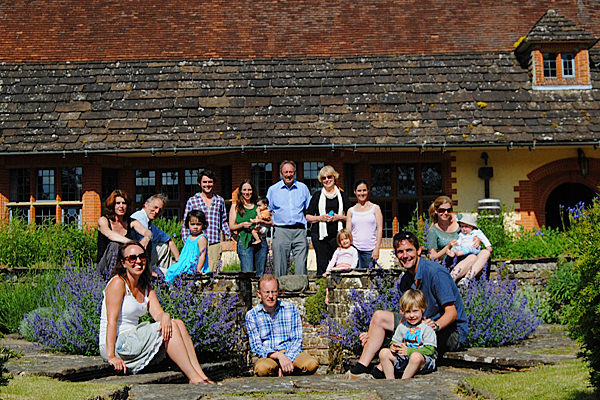
"We were sixteen people at Goddards this weekend to celebrate my brother’s 40th, 14 staying in the house (12 beds, 2 travels cots), two in pub down the road (not great as it turned out, and – weirdly – closing its doors for good on Wednesday). It was only three nights, and five of our party were under 5s, and still the catering was industrial. Eight smoked haddock (kedgeree on Friday night), 16 avocados (starter for the birthday feast) and a monumental 48 eggs (we like eggs as a family, I blame my Dad who always carries a hardboiled egg in his pocket case of emergency).
Oldest guest 83 (great-step-uncle), youngest, 8 months (tiny nephew); furthest departure point 5,000 miles (my sister and her two daughters from Bombay). Number of words read of my book on the army of Charles II: absolutely none. My birthday brother, ever the optimist, packed a barbeque in the back of their Mini. I, on the other hand, remembering our visit to Ascog on Bute last year, ordered six bags of logs. Come Monday morning, thanks to the sort of weather that exists only in childhood memories, the logs lay untouched, and we had between us a medley of sardines and rounders-related injuries and patches of sunburn from a weekend spent entirely outdoors.
The wooded byways that surround Goddards have been one of my million discoveries since I joined the Landmark Trust almost a year ago. With no point of Surrey more than 50 miles from Piccadilly Circus, it’s easy to assume it’s an endless sprawl of executive homes, a whole county of stockbroker suburbia. The reality is a real surprise; Surrey is, amazingly, England’s most wooded county, with mile upon mile of deep set tree-lined back roads, the depth of the gullies they have scored into the land testimony to their sheer age.
Goddards itself, built by Lutyens in 1899, is modern by comparison with so much of what surrounds it. The land was bought by Lutyens’s client from the heirs of the diarist John Evelyn, whose great-grandfather had made a fortune by introducing gunpowder into England. Evelyn was born and brought up here as the English civil war raged, learning from these leafy acres of the revolution that was unfurling and of the execution of the King. Close by at Arbury is the gorgeous garden he later designed for his neighbour, with a massive terrace over a quarter of a mile long, and pierced by grottoes and tunnels. Incredibly, it’s all still there, and this Surrey landscape would be more recognisable to him today than almost anything else he recorded in his famous diary almost four hundred years ago.
As I sat silently with my father inside a hollow yew bush waiting for someone to discover us on the umpteenth round of sardines I felt, as I often do at a Landmark, an overpowering sense of the infinite lives that preceded ours in these extraordinary places. Then my four-year-old daughter pushed through the hedge, her dress hairy with mown grass, and wearing a stripy turban of knotted leggings as an improvised sunhat, and the ghosts evaporated. And as we three sat cross-legged in our woody cave, she picking the shell from a hardboiled egg from her grandfather’s pocket, I felt a wave of sheer joy at the present."